By: Richard Van Heertum
This three-part series explores the demographic, political framing and outside influences that led Trump on the road to his unlikely victory. Included below is Part 3, which looks at outside factors that influenced the electoral victory of Trump and the Republicans.
The Question
How much did the context in which the 2016 election took place and events not directly part of the two campaigns influence it? That is to say, how much of Trump’s victory was less a factor of his (or Clinton’s) campaigning and more a result of how they reacted to the particular environment of the USA in 2016? In this final part of the series, I look at five major outside influences on the election and broader trends in the public that might have facilitated Trump’s victory.
The Short-Short Version
A presidential victory for Donald Trump does not emerge out of nowhere; it instead indicates a ferment waiting to be set aflame. In America, growing inequality, poverty and racial animus have been festering below the surface for decades, waiting for a proper champion to give that anger an outlet to explode. In the election of Trump and the miasma of violence, confusion and anger that has followed, we have scraped away the thin veil of civility that concealed a growing fury. Far too many Americans rightfully feel that their quality of life has declined and that the prospects for the future are bleak. Many Americans live in fear of not only terrorism but of looming danger from every corner of their lives – whether it be killer bees or the fact the bees are now dying at alarming rates. And whether we want to admit it or not, many of those same Americans are looking for someone to blame for the declining state of the country.
Some blame Corporate America and elites inside and outside Washington. Many of them turned to Bernie Sanders as their champions and a subset then shifted their support to Trump upon Clinton’s Democratic primary victory. Others believe it is the government itself that is to blame, along with the (suspected to be) largely corrupt politicians who inhabit it. They are ripe for the message of the GOP and, in this case, Trump. As an outsider, he is able to feed their fundamental cynicism of our institutions, not only governmental but the media as well.
And there are others still who blame the very groups most hurt by the reality of a new global America – blacks, Latinos, immigrants and Muslims. This group wants a scapegoat to feed their feelings of victimization, a human face they can point to and blame for their fading access to the American dream. Most authoritarian figures chose one group to focus their enmity upon, but Trump took the radical step of unifying his movement against them all. He incessantly attacked women, blacks, Muslims and illegal immigrants, as well as our most cherished public institutions, including the legal system, Congress, the Oval Office and, of course, the media. Through his more ecumenical policy of scapegoating, he was able to create a unified band of Americans willing to put their faith in a man who many might have otherwise thought of as part of the very elite he consistently excoriated. At the same time, he effectively labeled Clinton as embodying the traits of most of these groups. And it worked for enough Americans in key states to lead him to victory.
1 – FBI Director James Comey played a significant role
It is hard to believe that the reopening of the Clinton email investigation on October 28 played no role in the outcome. At that point, Clinton was up by as much as 12 points, Trump looked defeated and the election was moving towards a rout. After the announcement, which was unprecedented in modern electoral history and hearkens back to Jefferson’s largely warrantless attacks on John Adams close to 200 years ago, Clinton’s lead shrunk to the point where some polls had Trump ahead. The FBI did eventually announce the new emails had not changed their conclusions from July on the eve of the election, but it was too late for many voters, who appeared to see it as the last straw in a series of attacks on Clinton’s character and honesty that Trump had capitalized on throughout the campaign.
Data does back this finding up to some extent as, among the eight percent who reported deciding “in the last few days,” Trump won 46% to 44% and among the additional 6% who reported deciding “in the last week,” Trump won 50% to 38%. I believe that last number is the more telling, as it seems to indicate a group of voters who read the FBI message and decided that was the last straw for Hillary. More damning, in the nine days between Comey’s initial statement and his “all clear,” 24 million people cast early ballots, roughly 18% of the expected total.1 Beyond this, the exit polls showed that 63% of voters said that Clinton’s “use of private email” bothered them “a lot” or “some,” and, among them, Trump won 70% to 24%. There is no way to prove the true effect of the email scandal and Comey’s role in the election without substantial on the ground research, but it is a relatively strong, if largely contextual, finding that gives credence to those who believe he played an undue and unjust role in this election.
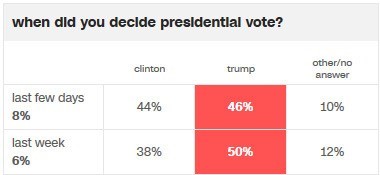
Source: CNN Exit Polls 2016.
2 – WikiLeaks and mainstream media arguably complicit as well
The press has paid little attention to a rather startling admission made after the election by the Russian Deputy Foreign minister Sergei A. Ryabkov. He claims that Russia was in contact with the Trump team during the campaign,2 meaning that the country suspected of working in concert with WikiLeaks to release private emails from Clinton and the DNC might well have been working in tandem with the candidate who benefitted most from those releases (as pointed out above). And since the election, Trump and Putin have apparently spoken about improving relations between the countries, including a collective effort to fight the war on terror, negotiations to resolve the Syrian situation and, potentially, more economic cooperation.3 This is an incredibly troubling finding and could indicate a candidate using a foreign government to help him get elected. I know of no precedent in this regard and wonder if it is illegal, but it certainly speaks to some troubling and hypocritical behavior by Trump, who has sold America on a largely isolationist future.
Beyond the Russians and WikiLeaks, I think it is fair to argue the media has been marginally complicit in electing Donald Trump President. While a little outdated at this point, an interesting study by Dataface in September found some interesting results regarding election coverage over the previous year. Among other findings, they discovered that Trump had over twice as many stories (14,924) about him as Clinton, that both candidates coverage vacillated from good to bad, that positive coverage of Clinton waned as we moved closer to election day and that media coverage largely stayed fixated on Trump throughout.4
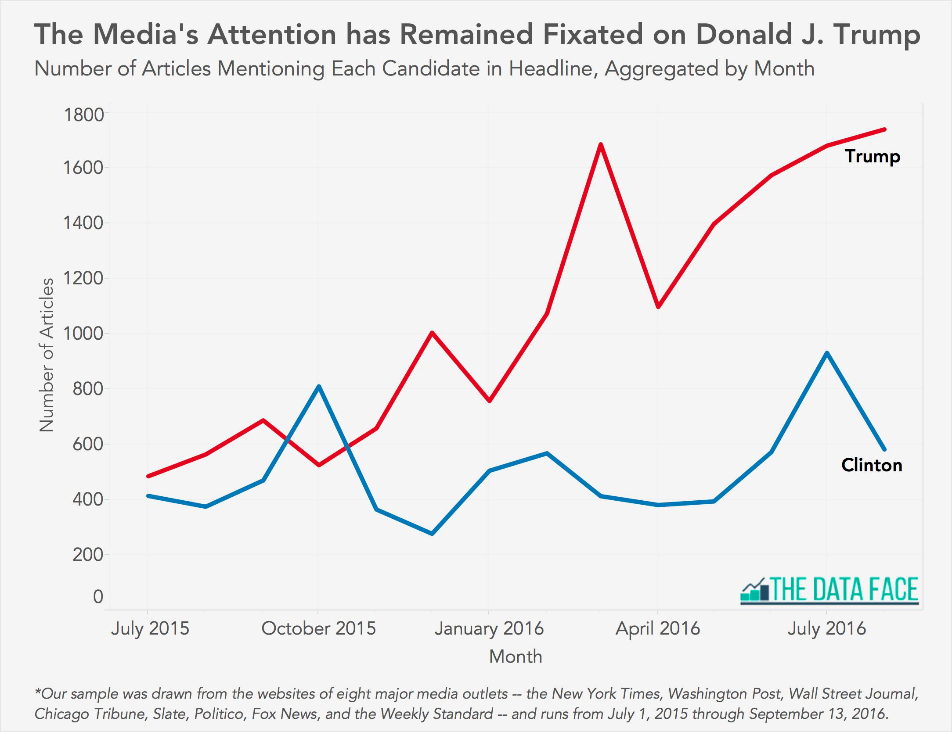
Source: Dataface – Trump Media Analysis.
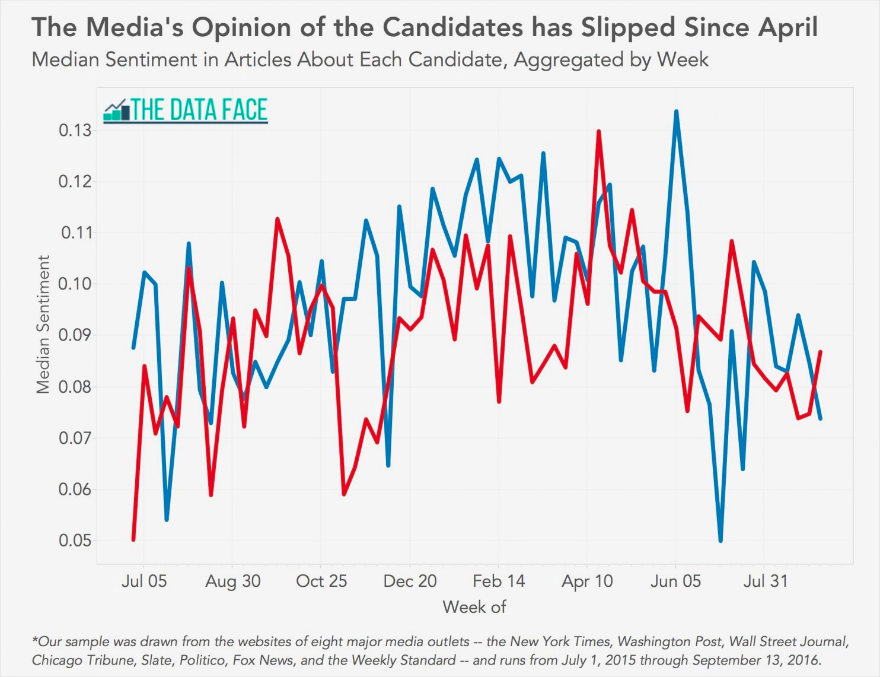
Source: Dataface – Trump Media Analysis.
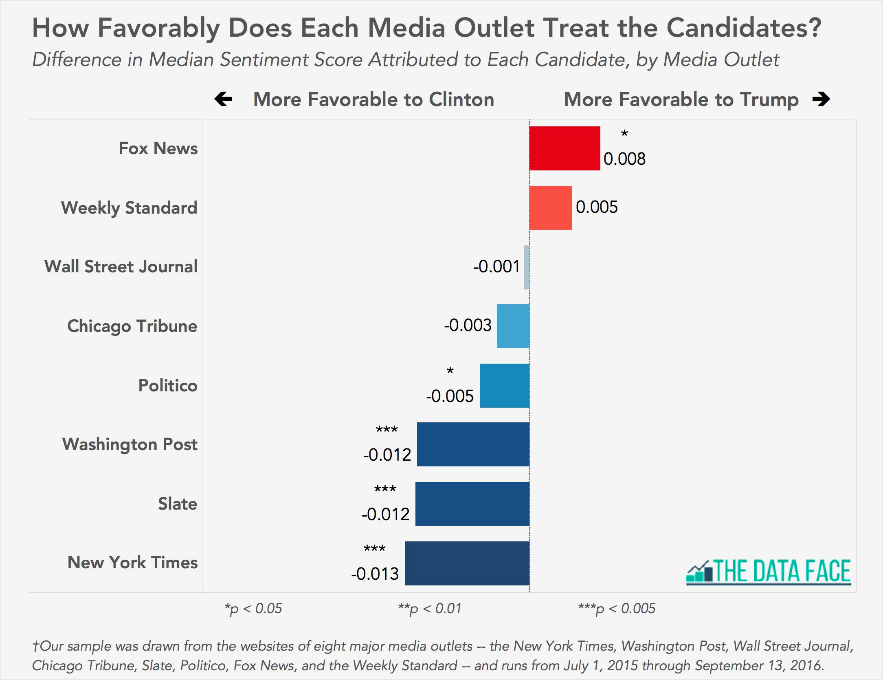
Source: Dataface – Trump Media Analysis.
Beyond this are the salient facts that the press gave Donald Trump billions of dollars in free press by focusing so much on his campaign – in both a positive and negative light. The very fact that so many now distrust the media might have amplified this effect, as their negative coverage of Trump only emboldened those who feel the liberal media establishment is inherently biased against their interests. And, as the New York Times argued in a piece on November 14, the general negative tenor of the media in its political coverage might have also fed into Trump supporters’ anger, helping to create and foster it in the first place. Finally, as Salon argued in their own diagnosis of the media’s impact on this election, they fed the electorate’s distrust of Clinton by playing up the email story without context or sufficient criticality, failing to fact check the statements of both candidates sufficiently and helping to normalize Trump’s campaign even as they incessantly critiqued it.
3 – The echo chamber of political insularity in America is destroying our democracy
A five-volume series could be written on this issue alone, but suffice it to say that the increasingly endogenous nature of many Americans forms of media consumption helps to build bubbles of coverage that simply reinforce what we already believe.
We see this with Facebook’s newspaper and news feeds, with television and radio stations, partisan websites and blogs and news aggregators that can allow a person to live in an echo chamber full of confirmation bias while ignoring the opinions of others and, of course, facts that might challenge their deeply held beliefs. The partisan nature of American politics today appears to have spread from Congress and the punditocracy to many households across the country, creating a world where people hold steadfast to their beliefs no matter how relevant or empirically-based the arguments of their “enemies.”
Even searching Google (generally accepted to be a bipartisan algorithm) for the popular vote results leads with a number of right wing sites that fallaciously claim Trump, in fact, won the popular vote.5 An angry, cynical electorate is more likely to believe whatever conspiracy theory best fits their worldview, unmoved by evidence that contradicts it. In fact, that leads to a fourth point.
4 – Fake News May Have Bamboozled the Public
Fake News has become a huge problem, manipulating the public to believe stories that are based on partial truths or outright lies. BuzzFeed argued, after performing a data analysis after the election, that fake election news stories on Facebook actually generated more engagement than the top stories from major news outlets including the New York Times, Washington Post, Huffington Post, NBC News, and others.6
The harrowing reality, as indicated in the image above, is that during the final, critical months of the campaign, 20 top-performing false election stories from hoax sites and hyperpartisan blogs generated 8,711,000 shares, reactions, and comments on Facebook, compared with 7,367,000 shares, reactions, and comments for the top 19 articles from reputable sources. Google and Facebook have been called to task since the election for their inability to block these stories, even as they continue to improve their increasingly complex approaches to micro-targeted advertising. Fake news had the power to spread all sorts of false stories, with the vast majority supporting Trump and some of his conspiracy theory ideas about Clinton. Among the many, one that stands out is that the Pope had endorsed Trump. A quick fact check would have warned readers of that story that it was not true, but his incredible performance among white christian evangelicals (as noted in part I of this report), might have something to do with this story.
Distrust of the media in general, while arguably skewed from reality,7 has emboldened millions of conservatives to ignore it in lieu of right-wing media sources like Fox News, The Drudge Report and Breitbart. This reinforces the notion that political insularity is profoundly challenging not only the power of the fourth estate to check power, but our democracy itself. As Jefferson once argued, “If a nation expects to be ignorant and free, in a state of civilization, it expects what never was and never will be.”
5 – Obstructionism Works
A final point worth making is that the obstructionism of the Republican Party appears to work wonders. They used it to some extent during the first Clinton term, turning the House of Representatives red for the first time since 1952, as a result of an incredible 54-seat swing. They have held the House for most of the 22 years since, blocking most legislation from Democratic Presidents and Senators when they are not in power (unless it involves Democrats moving to the right), and then pushing through their agenda whenever they have sufficient power in the three legislative bodies. This strategy has led to historically low approval ratings for Congress in general, but not to the electorate turning against the Republican Party to the extent one might assume.
Two years after Obama was elected, the GOP used the anger of some Americans, together with extensive funding from the Koch brothers, to build the Tea Party movement, which has radicalized Washington to heretofore unparalleled levels. This is most obvious with the debt ceiling tactics used over the past several years and failing to even consider Obama’s nomination to fill the current vacancy in the Supreme Court. But it is used in small or large ways much more frequency, shutting down government and then blaming Democrats for the partisan deadlock. The strategy, in simple terms, is to block as much legislation as possible when they are out of power, pushing Democratic presidents to compromise to get anything through Congress, then pushing through their agenda without any compromise when they are in power. Too many Americans seem oblivious to this reality, too frequently choosing the very Republicans who have created the gridlock to end it. One must admit that this is one of the strategies employed by Trump in this election, even as he admittedly played no part in the inaction that benefitted him so much.
Conclusion
Looking at the 15 points above, one finds an America that is more partisan, more cynical and more ideologically split than at any time in recent memory. Trump crafted himself as an outsider demagogue who was the only answer to the gridlock and ineffectiveness currently plaguing our political process and democracy. Clinton became the embodiment of a political establishment that can no longer solve the problems so many Americans face. She symbolized a corrupt system where politicians move seamlessly between public and private life feeding on the fealty of a corporate state that has captured our democracy, making it a servant to its self-interested ends of profit maximization and “free” markets. The election turned on these differentiated visions of leadership and the potential for change.
Trump did win big among whites, arguably capitalizing on political rhetoric that was anti-immigrant, anti-Muslim, anti-women and anti-black, but sifting through the data shows a more complex set of factors that led him to victory. Among them was the poor strategic planning of the Clinton team, the inability to get out the minority vote to the extent expected, to win by a large enough margin among whites or to galvanize the young to take to the voting booths as they did eight years ago. Trump won big in rural areas while Clinton lost margins and voters in the urban centers. And the general tenor of politics today meant the candidate most associated with change had the best opportunity to sway an electorate who has lost faith and hope.
America now stands on the precipice of a Trump presidency, a reality few foresaw. If the past couple of weeks are any indicator of where that will lead us, there is great cause for concern. He appears poised to carry through with his mass exportation of illegal immigrants, to explore routes to attack the civil liberties of Muslims, to provide the largest tax cut to the wealthy and Corporate America since Ronald Reagan, to gut the EPA and most attempts to stem global warming and to govern with an authoritarian style that could further erode our democracy. The great hope, of course, is the people and their dedication to stand up to the power elite and demand change that actually benefits the majority of us. Whether that will occur in the ferment of unrest, anger, cynicism and violence currently beseting the country is the question that we must answer in the coming years.
1 “Hillary blames Comey: Clinton tells donors she was ‘leading by large margins’ before white women sitting on the fence were swayed by FBI director’s decision to reopen email probe,” The Daily Mail, 12 November 2016.^
2 David Filipov and Andrew Roth, “Moscow had contacts with Trump team during campaign, Russian diplomat says,” The Washington Post, 10 November 2016. ^
3 Emma Burrows and James Griffith, “Trump, Putin speak about future of US-Russia ties,” CNN, 15 November 2016.^
4 John Sides, “Is the media biased toward Clinton or Trump? Here is some actual hard data.,” The Washington Post, 20 September 2016.^
5 Chris Riotta, “2016 Final Presidential Election Results: Google Falsely Shows Trump Leading Clinton In Popular Vote,” The International Business Times, 15 November 2016.^
6 Craig Siverman, “This Analysis Shows How Fake Election News Stories Outperformed Real News On Facebook,” BuzzFeed News, 16 November 2016.^
7 Eric Alterman, “ What Liberal Media?,” 6 February 2003.^
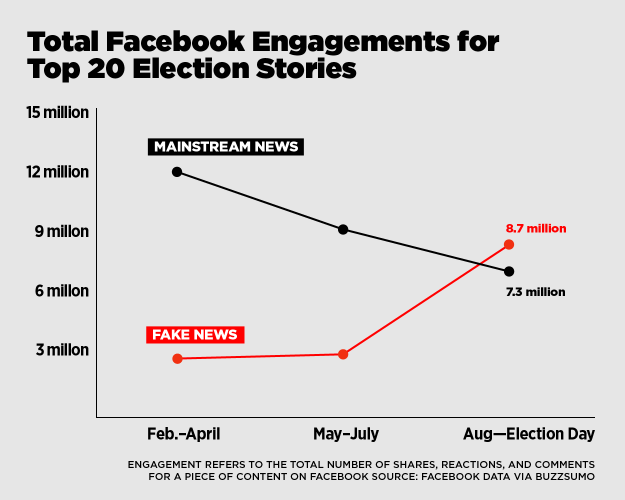
No Comments on "Election postscript: Outside factors and the context of Trump’s upset win"